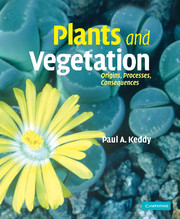Book contents
- Frontmatter
- Contents
- Preface
- Acknowledgements
- Chapter 1 Plants and the origin of the biosphere
- Chapter 2 Description of vegetation: the search for global patterns
- Chapter 3 Resources
- Chapter 4 Stress
- Chapter 5 Competition
- Chapter 6 Disturbance
- Chapter 7 Herbivory
- Chapter 8 Positive interactions: mutualism, commensalism, and symbiosis
- Chapter 9 Time
- Chapter 10 Gradients and plant communities: description at local scales
- Chapter 11 Diversity
- Chapter 12 Conservation and management
- Questions for Review
- References
- Index
- References
Chapter 6 - Disturbance
- Frontmatter
- Contents
- Preface
- Acknowledgements
- Chapter 1 Plants and the origin of the biosphere
- Chapter 2 Description of vegetation: the search for global patterns
- Chapter 3 Resources
- Chapter 4 Stress
- Chapter 5 Competition
- Chapter 6 Disturbance
- Chapter 7 Herbivory
- Chapter 8 Positive interactions: mutualism, commensalism, and symbiosis
- Chapter 9 Time
- Chapter 10 Gradients and plant communities: description at local scales
- Chapter 11 Diversity
- Chapter 12 Conservation and management
- Questions for Review
- References
- Index
- References
Summary
Definitions. Properties: duration, intensity, frequency, area. Fire. Erosion and deposition. Animals: beaver ponds and ‘gator holes. Burial by rivers. Flooding. Ice damage. Exposure to waves: chronic low level disturbance. Catastrophic events: landslides, volcanoes, and meteors. Comparing disturbance effects. Gaps and gap dynamics. Buried seeds. Mosaics for duck production. A synthetic view: fire, drought and flooding in the Everglades. Broad scale comparisons.
Introduction
Disturbance is an all pervasive process in communities and ecosystems (e.g., Huston 1979, Sousa 1984, Pickett and White 1985, Botkin 1990), but disturbance is perhaps a dangerous concept in ecology. It is dangerous precisely because the word is non-technical; therefore, many people assume they understand it when they do not. Moreover, in popular use, the word disturbance includes so many effects that it hardly excludes anything in nature. It may encompass everything from a deer walking across a peatland, to a meteor colliding with the Earth. It may include everything from a botanist collecting plant specimens to an all-out nuclear war followed by nuclear winter. Words that mean everything end up meaning nothing. Disturbance shall be defined here as a short-lived event that causes a measurable change in the properties of an ecological community.
This at first may seem vague. What is short-lived? Southwood (1977, 1988) suggests measuring duration in terms of organisms' life spans. Short-lived can be defined as an event that occurs as a pulse with duration much shorter than the life span of the dominant species in the community.
- Type
- Chapter
- Information
- Plants and VegetationOrigins, Processes, Consequences, pp. 225 - 283Publisher: Cambridge University PressPrint publication year: 2007



